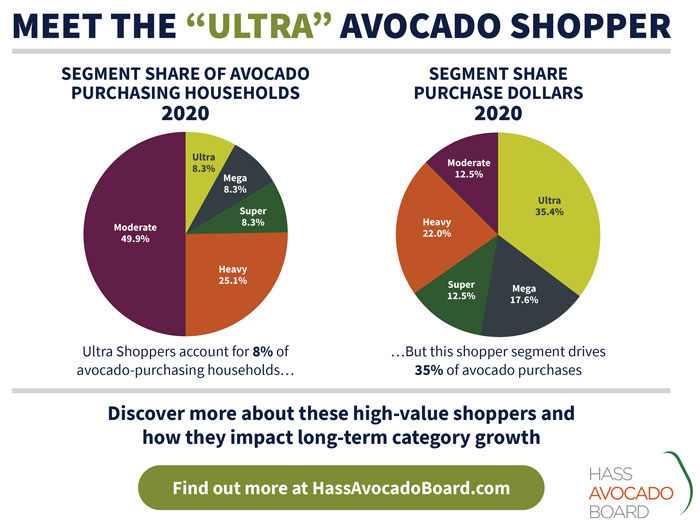Ultra-Avocado Shoppers Make Significant Impact On Category
March 9, 2022 | 3 min to read

MISSION VIEJO, CA – Understanding fresh avocado shoppers and their purchase behaviors help marketers and retailers create strategies that drive traffic, build loyalty, and grow sales of fresh Hass avocados. In the rapidly evolving retail landscape, market dynamics are heavily influenced by shopper characteristics and behavior.
A recent avocado shopper segmentation study by the Hass Avocado Board (HAB), available for free download on hassavocadoboard.com/business-support-tools, determined that a small subset of avocado-purchasing households, known as Ultra shoppers, make the most significant impact on the category. Ultra shoppers were found to be the top-spending segment, making up eight percent of avocado buying households. However, this segment accounts for 35% of the total U.S. annual avocado purchase dollars. Ultra shoppers exhibit purchase behaviors that far exceed that of other segments, driving their disproportionate impact on the avocado category.
- Ultra shoppers spent an average of $100 per household annually, two times that of Mega shoppers and seventeen times that of Moderate shoppers. This annual spend was driven by more purchase trips and a higher spend per trip.
- Ultra shoppers visited retailers more often and were more likely to purchase avocados during their visit than any other shopper segment. On average, Ultra shoppers made 183 trips per year to the retailer and purchased avocados during 14% of their trips. In contrast, Moderate shoppers made 153 trips and purchased avocados during two percent of their trips.
However, the Ultra segment is not the only high-valued segment in the category. Mega and Super shoppers also made a disproportionately large impact on category purchases.
Mega and Super shoppers accounted for a larger share of avocado dollars than their respective share of households would suggest. Each segment represented eight percent of avocado-purchasing households, while Mega shoppers accounted for 18% of avocado purchases and Super shoppers accounted for 13%. Combined, Ultra, Mega and Super shoppers made up 25% of all avocado-purchasing households and 66% of avocado dollars.
As marketers and retailers work to understand the changing retail marketplace better, the findings in the Shopper Segmentation study highlight opportunities within these new avocado shopper segments, particularly with Ultra households. Retailers and marketers can capitalize on key opportunities from this study to generate excitement and engage with Ultra and Mega households by using promotional incentives to increase avocado purchase conversion. Overall, these segments serve as a solid foundation to help avocado marketers and retailers zero in on their target as they further define their avocado shoppers. Download a copy of the full study and action guide for more information about these defined shopper segments, including key insights, shopper trends and profiles.
The study is based on household purchase data from the IRI Consumer NetworkTM. HAB offers these insights and detailed retail information as the only avocado organization that equips the entire industry for success, with clear and actionable data and metrics that all can use to drive their avocado business. To learn more about the impact of bagged avocados and the households that purchase them, visit hassavocadoboard.com/business-support-tools.
About The Hass Avocado Board
The Hass Avocado Board (HAB) exists to help make avocados America’s most popular fruit. HAB is the only avocado organization that equips the entire global industry for success by collecting, focusing and distributing investments to maintain and expand demand for avocados in the United States. HAB provides the industry with consolidated supply and market data, conducts nutrition research, educates health professionals, and brings people together from all corners of the industry to collectively work towards growth that benefits everyone. The organization also collects and reallocates funds to California and importer associations to benefit specific countries of origin in promoting their avocado brands to customers and consumers across the United States.
